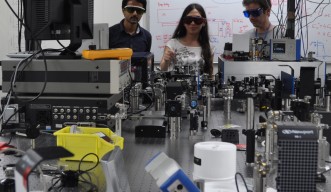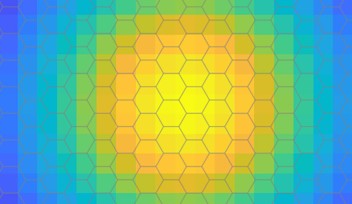The Next Generation of Stuff
Since our ancestors first began using tools to dig for insects or club rivals, we’ve been constrained by what seemed to be fundamental properties of matter. Light will bend in a certain way when it passes through glass, for example, and pumping energy into something will heat it up. Then, in the last few decades, the ability to engineer materials on the nano scale has re-written the basic rules of material science. For instance, the color of a gold particle isn’t always yellow–it changes according to the size of the particle. In recent years scientists, including OIST Professor Keshav Dani, have begun to understand how these nano engineered materials, together with the rules of quantum mechanics and relativity, allow us to make materials that violate the familiar rules about how stuff behaves.
Dani’s Femtosecond Spectroscopy Unit uses lasers to study two types of these next-generation materials: metamaterials and Dirac materials. Metamaterials are materials designed to have specific optical, acoustic, electromagnetic, or other properties. Scientists have historically faced a major limitation in trying to tune the properties of materials, namely, that it isn’t possible to engineer the behavior of each of their electrons. In recent years, though, researchers have begun to figure out how to do an end-run around this limitation by making materials out of artificial particles designed to behave in certain predictable ways. Such metamaterials have extraordinary potential: they could be used to bend light around objects to render them invisible, for example, or, conversely, could manipulate light waves to make visible objects that are otherwise too small to be seen. One current project in Dani’s unit is to test and improve a recently-developed photonic metamaterial to enable faster, smaller and more-efficient telecommunication devices.
The unit is also interested in Dirac materials, which are named for a theorist who in the 1920s described the behavior of very high-energy relativistic electrons usually found in neutron stars, white dwarfs, and far-away galaxies. Later, in the 1960s, theorists predicted that carbon atoms bound in a special two-dimensional lattice would also have electrons that exhibit this behavior. It wasn’t until 2004, however, that two researchers managed to isolate such a two-dimensional sheet from pencil lead and study its properties in detail. This two-dimensional graphite, called graphene, has opened up a new field of research into materials with distinctive—and tunable—optical, conductive, mechanical, and other properties. But to fully take advantage of these properties in a wide range of applications, particularly high-speed applications, researchers will need a better understanding of how their electrons interact on very short timescales, says Dani. Gaining this understanding is a central goal of his group. “We want to understand how electrons talk to each other on very short time scales, and what kind of novel properties that entails,” he says.
Specialties
Research Unit
For press enquiries:
Press Inquiry Form
















